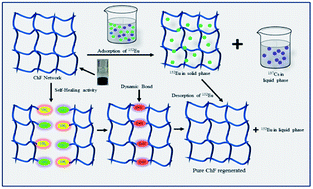A dynamic chitosan-based self-healing hydrogel with tunable morphology and its application as an isolating agent†
Abstract
A biopolymer chitosan based 3D hydrogel framework (ChF) with good transparency and rapid self-healing activity has been successfully synthesized and utilized to get high purity separation of long-lived fission products 152Eu (T1/2 = 13.33 a) and 137Cs (T1/2 = 30.17 a) employing solid liquid extraction (SLX) technique. The unique properties of covalently cross-linked polymeric ChF have been analyzed through FT-IR, solid-state 13CP/MAS NMR, rheological measurement, SEM, AFM, TG-DTG, DSC, XRD and swelling study. Rheological analysis reveals that the maximum mechanical strength of a hydrogel is achieved upon synthesis using 1 : 0.43 chitosan to formaldehyde stoichiometry (ChF3). A plateau of storage modulus (G′), over a wide range of angular frequency of ChF reveals its visco elastic nature. On varying the cross linking of the hydrogel network, we found a precise tuning of morphology and properties of ChF. This ChF was utilized to separate 152Eu from a mixture of 152Eu and 137Cs in aqueous HCl medium (pH 5) using SLX technique and it was observed that ChF specifically adsorbs 152Eu without any contamination from 137Cs. 152Eu was back extracted easily using 1 M aqueous HCl from 152Eu-adsorped-ChF. The adsorption of 152Eu on ChF is influenced by pH, amount of hydrogel, time of contact, temperature, cross-linking density and dosage of γ-radiation. To establish the self-healing property of the gels, rheological analysis through step-strain measurements (strain = 0.1 to 100%) at 25 °C was monitored. The polymeric hydrogel network displays a reversible sol–gel transition for several cycles due to the dynamic equilibrium between the Schiff base linkage and the aldehyde and amine functional groups.


 Please wait while we load your content...
Please wait while we load your content...